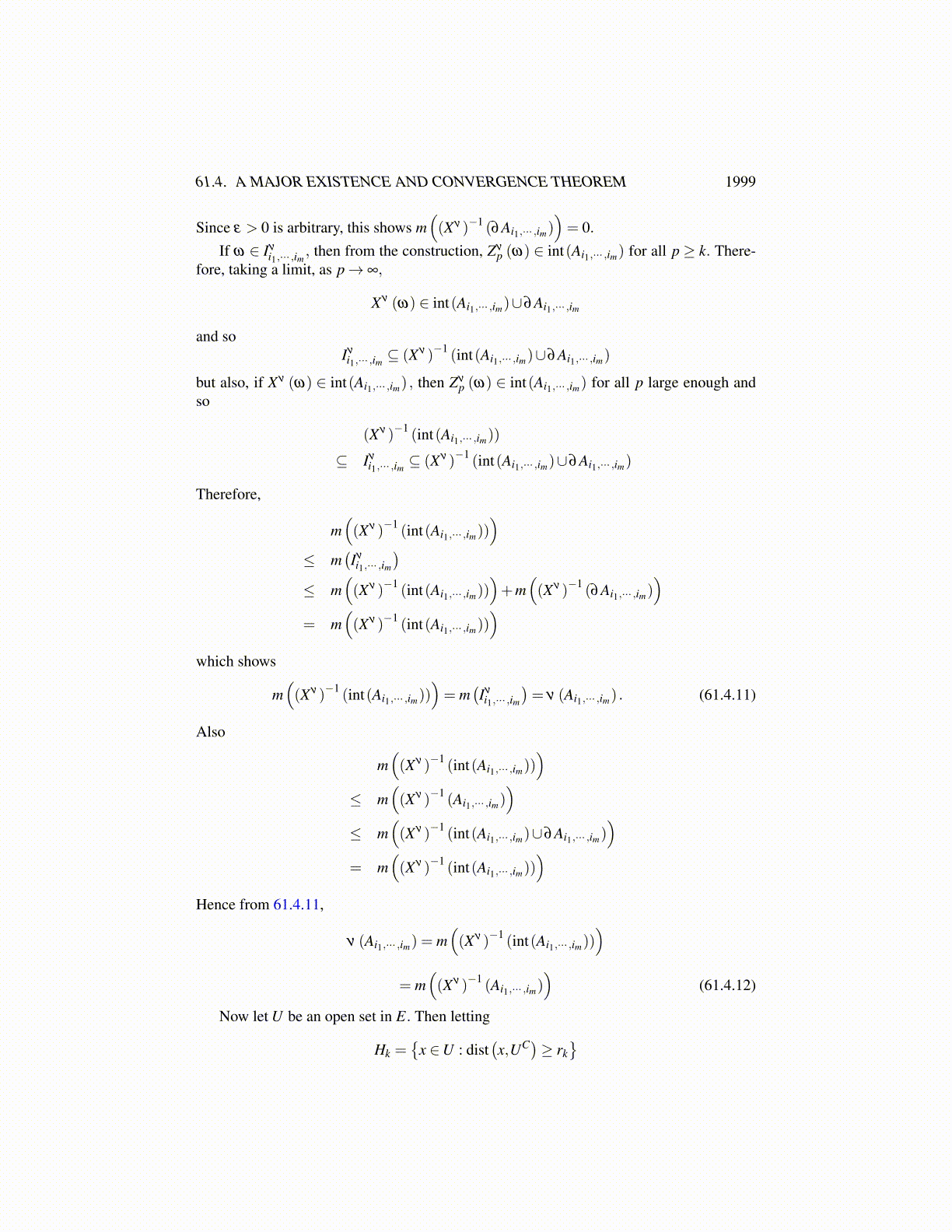
61.4. A MAJOR EXISTENCE AND CONVERGENCE THEOREM 1999
Since there are only finitely many sets in the union, there exists s≤ k−1 such that every ballabout x contains points of Cri
s but from 61.4.10, every ball about x contains points of(Cri
s)C
which implies x ∈ ∂Cris ⊆ F by induction. It is not possible that d (x,ak)> ri and yet have
x in ∂Crik . This follows from the description in 61.4.10. If d (x,ak) = ri then by definition,
x ∈ F. The only other case to consider is that x /∈ int(B(ak,ri)∩C) but x ∈ B(ak,ri). From61.4.10, every ball about x contains points of C. However, since x ∈ B(ak,ri) , a smallenough ball is contained in B(ak,ri) . Therefore, every ball about x must also contain pointsof CC since otherwise, x ∈ int(B(ak,ri)∩C) . Thus x ∈ ∂C⊆ F by assumption. Now applywhat was just shown to the case where C = E, the whole space. In this case, ∂E ⊆ Fbecause ∂E = /0. Then keep applying what was just shown to the Ai1,··· ,in . This proves theclaim.
From the claim, ν (int(Ai1,··· ,in)) = ν (Ai1,··· ,in) whenever ν = µ or µn. This is becausethat in Ai1,··· ,in which is not in int(Ai1,··· ,in) is in F which has measure zero.
Some functions on [0,1)
By the axiom of choice, there exists xi1,··· ,im ∈ int(Ai1,··· ,im) whenever
int(Ai1,··· ,im) ̸= /0.
For ν = µn or µ, define the following functions. For ω ∈ Iνi1,··· ,im
Zνm (ω)≡ xi1,··· ,im .
This defines the functions, Zµnm and Zµ
m. Note these functions have the same values but onslightly different intervals. Here is an important claim.
Claim 2 (Limit on µn): For a.e. ω ∈ [0,1), limn→∞ Zµnm (ω) = Zµ
m (ω) .Proof of the claim: This follows from the weak convergence of µn to µ and Lemma
61.4.1. This lemma implies µn (int(Ai1,··· ,im))→ µ (int(Ai1,··· ,im)) . Thus by the construc-tion described above, µn (Ai1,··· ,im)→ µ (Ai1,··· ,im) because of claim 1 and the construction
of F in which it is always a set of measure zero. It follows that if ω ∈ int(
Iµ
i1,··· ,im
), then
for all n large enough, ω ∈ int(
Iµni1,··· ,im
)and so Zµn
m (ω) = Zµm (ω) . Note this convergence
is very far from being uniform.Claim 3 (Limit on size of sets, fixed measure): For ν = µn or µ,{Zν
m}∞
m=1 is uniformlyCauchy independent of ν .
Proof of the claim: For ω ∈ Iνi1,··· ,im , then by the construction,
ω ∈ Iνi1,··· ,im,im+1··· ,in
for some im+1 · · · , in. Therefore, Zνm (ω) and Zν
n (ω) are both contained in Ai1,··· ,im whichis contained in B(aim ,rm) . Since ω ∈ [0,1) was arbitrary, and rm → 0, it follows thesefunctions are uniformly Cauchy as claimed.
Let Xν (ω) = limm→∞ Zνm (ω). Since each Zν
m is continuous off a set of measure zero, itfollows from the uniform convergence that Xν is also continuous off a set of measure zero.
Claim 4: For a.e. ω,limn→∞
X µn (ω) = X µ (ω) .